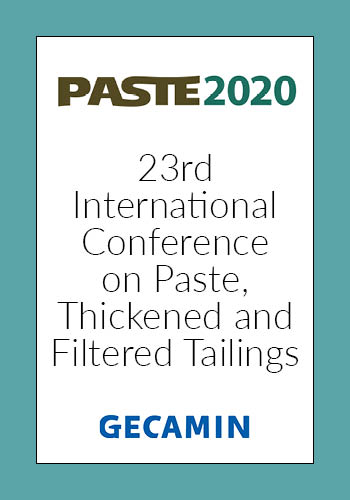Dewatering polymer application in an iron ore tailings dam

|
Authors: Braga, F; Guang, R; Pereira, J; Davo, J; Ferrari, F; Nicoli, T; Boxill, L; Russo, J |
DOI https://doi.org/10.36487/ACG_repo/2052_13
Cite As:
Braga, F, Guang, R, Pereira, J, Davo, J, Ferrari, F, Nicoli, T, Boxill, L & Russo, J 2020, 'Dewatering polymer application in an iron ore tailings dam', in H Quelopana (ed.), Paste 2020: 23rd International Conference on Paste, Thickened and Filtered Tailings, Gecamin Publications, Santiago, https://doi.org/10.36487/ACG_repo/2052_13
Abstract:
Given the current scenario experienced by Brazilian mining industry, the study and development of technologies that enable a more secure and controlled disposal of tailings has gained significant relevance. Among the various alternatives and disposal methodologies, Anglo American has been developing tests on different study fronts. Using dewatering polymers to improve tailings store potentials at tailings dam is one of the methods that has been studied extensively. The tested polymers can enhance de-watering performance and immobilization of mineral slurries during hydraulic deposition, therefore achieving optimization of tailings storage at the existing facility. The studies were divided into laboratory and industrial field-testing phases aiming to evaluate the applicability of this technology for eventual implementation at industrial scale. During the laboratory testing phase, more than two hundred tests were performed to determine the best polymer type, dilution and dosage. The parameters evaluated were based on yield stress measurements by a rheometer, slump tests performance and water released volume after 10 minutes and 24 hours after polymer addition. The results from laboratory testing phase have provided sufficient information for industrial scale trial. The second phase of the study consisted of an industrial field trial with polymer application in the tailings dam for five days. During the trial, topographic measurements were taken in order to evaluate the increase of settled material during the first kilometer after tailings discharge. The results demonstrated a significant increase of settled material and beach slope angle in the measured area. This showed a good potential for improved utilization of the storage in the tailings storage facility in the coming years.
References:
Bembrick, D., 2008, The impact of flocculant addition on a tailings storage facility, Metallurgical Plant Design and Operating Strategies, Perth, pp 541-549.
Costine, A., Benn, F., Fawell, P., Edraki, M., Baumgartl, T., Bellwood, J., 2018, ‘Understanding factors affecting the stability of inline polymer – amended tailings’, in RJ Jewell, AB Fourie (eds), Proceeding of the 21st International Seminar on Paste and Thickened Tailings, Australian Centre for Geomechanics, Perth, pp 103-116.
Guang, R., Longo, S., 2017, Application of in-line polymer addition for tailings disposal- learning and challenges part II, in A Wu, RJ Jewell (eds), in Proceeding of the 20th International Seminar on Paste and Thickened Tailings, Australian Centre for Geomechanics, Perth, pp 371-379.
Guang, R., Tshibang, M., Loayza, C., 2014, Application of in-line polymer addition for tailings disposal in Australia – learning and challenges, in RJ Jewell, AB Fourie, S Wells, D van Zyl (eds) in Proceeding of the 17th International Seminar on Paste and Thickened Tailings, Vancouver, InfoMine Inc, Canada, pp 87- 100.
Mizani, S., Soleimani, S., Simms, P., 2013, Effectos of polymer dosage and dewaterability, rheology and spreadability of polymer amended mature fine tailings, in RJ Jewell, AB Fourie, J Caldwell, J Pimenta (eds), Proceeding of the 16th International Seminar on Paste and Thickened Tailings, Belo Horizonte, Brazil, Australian Centre for Geomechanics, Perth, pp 117-131.
Riley, T.C., Utting, L., 2014, Polymer – modified tailings deposition – a management perspective, in RJ Jewell, AB Fourie, S Wells, D van Zyl (eds) in Proceeding of the 17th International Seminar on Paste and Thickened Tailings, Vancouver, InfoMine Inc, Canada, pp 179- 187.
Wells, P.S., Revington, A., Omotoso, O., 2011, Mature fine tailings drying – technology update, in RJ Jewell, AB Fourie (eds), Proceeding of the 14th International Seminar on Paste and Thickened Tailings, Perth, Australian Centre for Geomechanics, Perth, pp 155-166.
Wells, P.S., Riley, D., 2007, MFT drying – case study for the use of rheological modification and dewatering of fine tailings through thin lift deposition in oil sands tailings, in RJ Jewell, AB Fourie (eds), Proceeding of the 10th International Seminar on Paste and Thickened Tailings, Australian Centre for Geomechanics, Perth, pp 271-284.
© Copyright 2025, Australian Centre for Geomechanics (ACG), The University of Western Australia. All rights reserved.
View copyright/legal information
Please direct any queries or error reports to repository-acg@uwa.edu.au
View copyright/legal information
Please direct any queries or error reports to repository-acg@uwa.edu.au